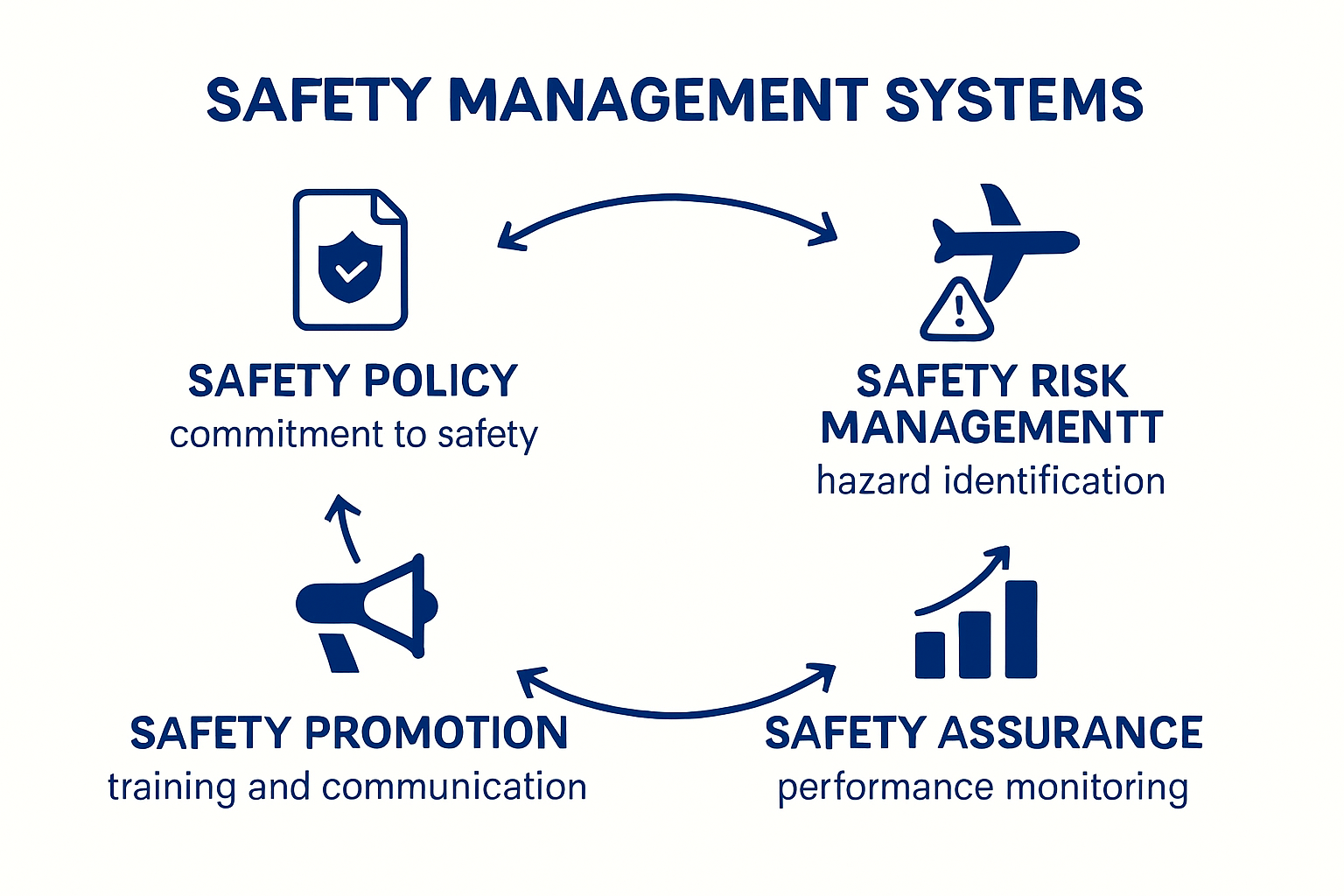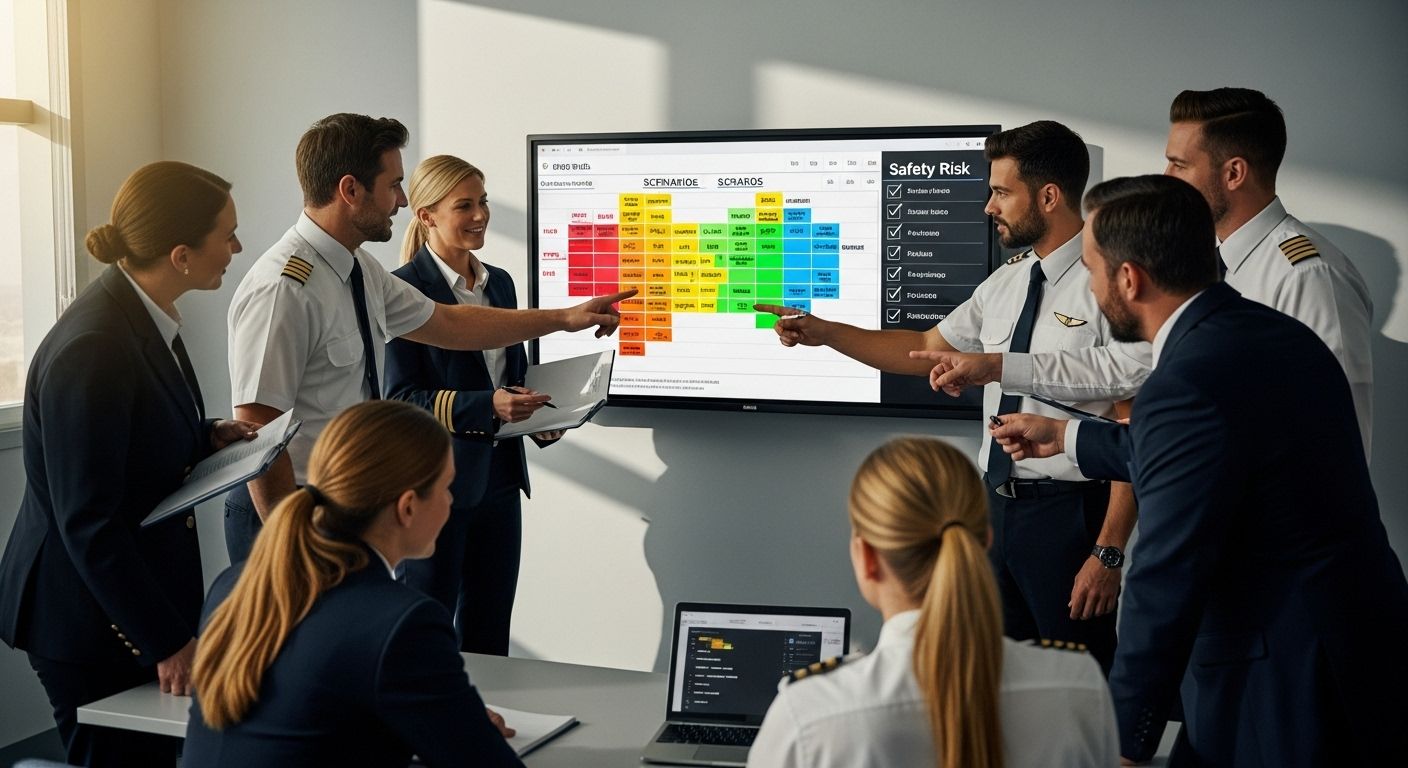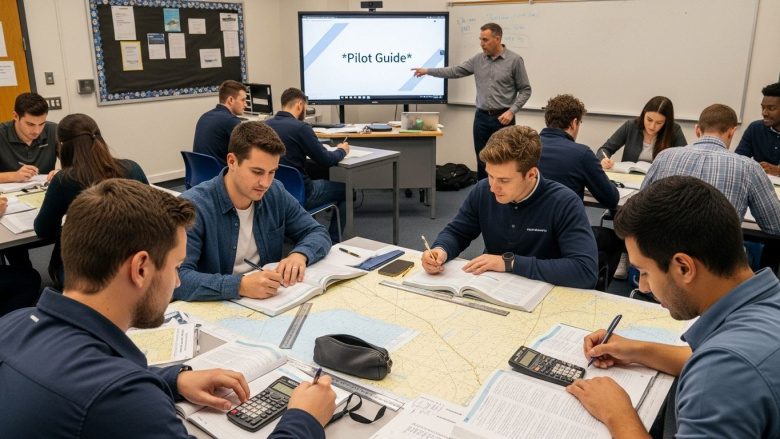Aviation safety is often seen as one of the most regulated and meticulously controlled fields in the world. Yet only around 10 percent of aviation incidents are due to purely technical faults, with the overwhelming majority linked to human factors or procedural gaps. This flips the common view completely. Because the real strength of aviation safety lies not just in strict rules or advanced technology, but in the culture and systems that help people spot and fix risks before they ever become newsworthy.
Table of Contents
- Understanding Aviation Safety Management Systems
- Core Components And Best Practices
- Benefits For Pilots And Aviation Professionals
- Implementing Safety Management In Real-World Scenarios
Quick Summary
| Takeaway | Explanation |
|---|---|
| Establish a clear safety policy | A documented commitment from leadership defining safety roles and responsibilities is essential. |
| Implement proactive risk management | Move from reactive to predictive strategies by identifying and mitigating risks before they arise. |
| Encourage a culture of safety | Foster open communication and reporting without fear, promoting continuous learning and improvement. |
| Utilise technological solutions | Leverage advanced technologies alongside human factors to enhance safety management and monitoring. |
| Invest in continuous professional development | Support training and skill refinement for aviation professionals to improve safety awareness and practices. |
Understanding Aviation Safety Management Systems
Aviation safety management systems (SMS) represent a critical framework designed to systematically manage safety risks and enhance operational security within the aviation industry. These comprehensive systems go beyond traditional reactive safety approaches, transforming how organisations identify, assess, and mitigate potential hazards.
The Core Principles of Safety Management Systems
At its fundamental level, an aviation safety management system is an organisational approach that prioritises proactive risk assessment and continuous improvement. Research from the European Union Aviation Safety Agency (EASA) indicates that SMS integrates multiple layers of safety processes, policy development, and risk management strategies to create a holistic safety culture.
The primary objectives of an SMS include systematic hazard identification, comprehensive risk assessment, and implementation of robust mitigation strategies. Unlike traditional safety protocols that primarily respond to incidents after they occur, modern SMS frameworks focus on preventing potential safety breaches before they transpire. This proactive methodology requires organisations to develop sophisticated monitoring mechanisms, data collection systems, and analytical tools that can predict and neutralise potential risks.
Key Components of Effective Aviation Safety Management
Successful aviation safety management systems typically encompass several critical components. According to international aviation safety research, these components include:
- Safety Policy: A clear, documented commitment from senior leadership establishing safety as a paramount organisational priority
- Safety Risk Management: Structured processes for identifying, analyzing, and mitigating potential safety risks
- Safety Assurance: Continuous monitoring and evaluation of safety performance and effectiveness of risk control strategies
- Safety Promotion: Ongoing training, communication, and cultural development to embed safety consciousness across all organisational levels

Implementing an effective SMS requires more than mere procedural compliance. It demands a fundamental cultural transformation where every member of the aviation ecosystem understands their role in maintaining safety standards. From ground staff to pilots, from maintenance technicians to air traffic controllers, each individual becomes a critical stakeholder in the organisation’s safety ecosystem.
The complexity of modern aviation necessitates an adaptive and intelligent approach to safety management. As technological advancements and operational challenges continue to evolve, aviation safety management systems must remain flexible, data-driven, and responsive. Learn more about our approach to safety management and how cutting-edge strategies are reshaping aviation safety protocols.
Ultimately, aviation safety management systems represent more than a regulatory requirement. They embody an organisational commitment to protecting human lives, preserving operational integrity, and maintaining the highest standards of professional excellence in an inherently complex and dynamic industry.
Core Components and Best Practices
An effective aviation safety management system (SMS) relies on a structured and comprehensive approach that goes far beyond mere compliance. Research from the European Union Aviation Safety Agency (EASA) highlights the critical importance of implementing robust practices that systematically address safety across organisational levels.
Establishing a Robust Safety Policy Framework
The foundation of any successful aviation safety management system lies in developing a clear, comprehensive safety policy. This policy must articulate an organisation’s commitment to safety, explicitly defining roles, responsibilities, and expectations for every team member. International Civil Aviation Organization (ICAO) guidelines emphasise that an effective safety policy should be:
- Unambiguously endorsed by senior leadership
- Communicated clearly throughout the organisation
- Regularly reviewed and updated to reflect changing operational environments
Key to this framework is creating a just culture that encourages open reporting and learning from incidents without punitive measures. This approach transforms safety from a compliance requirement into a collaborative, continuous improvement process.
Risk Management and Proactive Safety Strategies
Risk management represents the core operational mechanism of an aviation safety management system. Modern SMS approaches move beyond traditional reactive models, instead focusing on predictive and proactive risk identification and mitigation. This involves developing sophisticated data collection and analysis mechanisms that can anticipate potential safety challenges before they manifest.
Advanced risk management strategies include:
- Comprehensive hazard identification processes
- Quantitative and qualitative risk assessment techniques
- Development of targeted risk mitigation strategies
- Continuous monitoring and performance tracking
Learn more about advanced safety management techniques that are transforming aviation safety protocols and creating more resilient operational frameworks.
Safety Culture and Continuous Improvement
The most sophisticated safety management systems recognise that technology and procedures alone cannot guarantee safety. Creating a pervasive safety culture requires ongoing commitment, training, and engagement at every organisational level. This means developing communication channels that allow all personnel to contribute to safety discussions, report potential issues, and participate in continuous improvement processes.
Successful safety cultures are characterised by:
- Transparent incident reporting mechanisms
- Regular safety training and awareness programmes
- Open communication channels across hierarchical levels
- Recognition and reward systems that prioritise safety consciousness
Implementing these best practices requires a holistic approach that integrates technological solutions, human factors, and organisational processes. Aviation organisations must view safety not as a static requirement, but as a dynamic, evolving commitment to protecting human lives and maintaining operational excellence.
Benefits for Pilots and Aviation Professionals
Safety Management Systems (SMS) represent a transformative approach that provides substantial benefits for pilots and aviation professionals, extending far beyond traditional safety protocols.
For quick reference, the following table summarises key benefits of Safety Management Systems (SMS) for aviation professionals as discussed throughout this section.
| Benefit Area | Key Advantages |
|---|---|
| Professional Development & Risk Awareness | Advanced decision-making, improved situational awareness |
| Psychological Safety & Reporting | Open communication and non-punitive reporting |
| Career Advancement & Recognition | Leadership roles, mentorship, increased credibility |
Research from the European Union Aviation Safety Agency (EASA) demonstrates that these systems create a comprehensive ecosystem of professional development, risk mitigation, and continuous learning.
Professional Development and Risk Awareness
For aviation professionals, SMS offers unprecedented opportunities for professional growth and enhanced risk awareness. International Civil Aviation Organization (ICAO) studies highlight that these systems empower individuals by providing structured frameworks for understanding complex safety challenges. Pilots who engage with SMS develop advanced analytical skills, learning to identify potential hazards before they become critical incidents.
Key professional development advantages include:
- Enhanced critical thinking and decision-making capabilities
- Deeper understanding of systemic safety considerations
- Improved situational awareness during complex operational scenarios
- Opportunities for continuous learning and skill refinement
Psychological Safety and Reporting Culture
One of the most significant benefits of modern aviation safety management systems is the creation of a just and transparent reporting culture. Unlike traditional punitive approaches, contemporary SMS encourages open communication about potential safety issues without fear of professional repercussions. This psychological safety transforms how aviation professionals interact with safety protocols.
Learn more about professional collaboration techniques that support a robust safety reporting environment. The ability to share insights, report near-misses, and contribute to collective safety knowledge becomes a fundamental aspect of professional responsibility.
Career Advancement and Organisational Recognition
Professionals who demonstrate comprehensive understanding and implementation of SMS principles position themselves as valuable assets within the aviation industry. Advanced knowledge of safety management systems can differentiate pilots and aviation professionals in competitive career landscapes. Organisations increasingly value team members who can contribute to a proactive safety culture, viewing them as critical strategic resources.
Advancement opportunities associated with SMS expertise include:
- Leadership roles in safety management departments
- Advisory positions in regulatory compliance
- Training and mentorship responsibilities
- Enhanced credibility during performance evaluations
Ultimately, Safety Management Systems represent more than a technical framework. They embody a holistic approach to professional development, transforming how aviation professionals perceive, manage, and contribute to organisational safety. By embracing these systems, pilots and aviation professionals become active architects of a safer, more efficient aviation ecosystem.

Implementing Safety Management in Real-World Scenarios
Implementing Safety Management Systems (SMS) in real-world aviation scenarios requires a strategic, systematic approach that goes beyond theoretical frameworks. Research from the European Union Aviation Safety Agency (EASA) emphasises the critical importance of translating comprehensive safety principles into practical, actionable strategies across diverse operational environments.
Operational Integration and Organisational Alignment
Successful SMS implementation demands more than procedural compliance. It requires a fundamental transformation of organisational culture and operational processes. International Civil Aviation Organization (ICAO) guidelines highlight the necessity of creating seamless integration between safety management protocols and day-to-day operational workflows.
Key strategies for effective operational integration include:
- Developing clear communication channels across all organisational levels
- Creating standardised reporting mechanisms
- Implementing comprehensive training programmes
- Establishing robust data collection and analysis systems
Organisations must approach SMS as a dynamic, living system that continuously evolves with changing operational challenges and technological advancements.
Risk Assessment and Mitigation Techniques
Practical SMS implementation relies on sophisticated risk assessment and mitigation techniques. This involves developing nuanced approaches to identifying potential hazards, quantifying their potential impact, and creating targeted intervention strategies. Aviation professionals must move beyond generic risk management approaches, instead developing context-specific methodologies that address unique operational challenges.
Effective risk assessment approaches include:
- Comprehensive scenario planning
- Advanced predictive analytics
- Regular operational audits
- Continuous performance monitoring
Learn more about advanced safety management techniques that can transform how aviation organisations approach safety challenges.
Technological Solutions and Human Factors
Modern Safety Management Systems increasingly leverage technological solutions while maintaining a critical focus on human factors. The most successful implementations recognise that technology serves as a supportive tool, not a replacement for human expertise and judgment. Advanced SMS approaches integrate cutting-edge technologies like artificial intelligence and machine learning with comprehensive human performance analysis.
Technological integration strategies include:
- Implementing advanced data analytics platforms
- Developing real-time monitoring systems
- Creating intelligent reporting mechanisms
- Utilising predictive modelling techniques
Ultimately, implementing Safety Management Systems in real-world scenarios requires a holistic approach that balances technological innovation, human expertise, and organisational commitment. Aviation organisations must view SMS as a comprehensive ecosystem that continuously adapts, learns, and improves, ensuring the highest standards of safety and operational excellence.
Frequently Asked Questions
What is an aviation safety management system?
Aviation safety management systems (SMS) are frameworks designed to systemically manage safety risks and enhance operational security within the aviation industry by focusing on proactive risk assessment and continuous improvement.
What are the core components of an effective safety management system?
Key components of an effective SMS include safety policy, safety risk management, safety assurance, and safety promotion, all working together to create a holistic safety culture within an organisation.
How does a strong safety culture benefit aviation professionals?
A strong safety culture promotes open communication and a non-punitive reporting environment, which enhances psychological safety, encourages continuous learning, and ultimately contributes to the professional development of aviation personnel.
What role does technology play in aviation safety management systems?
Technology plays a crucial role in aviation SMS by providing advanced data analytics, real-time monitoring systems, and predictive modelling techniques that assist in risk assessment, hazard identification, and overall safety management.
Take Your Aviation Safety Knowledge Further With Certified Training
Have you been wondering how to turn advanced safety management system principles into your day-to-day skill set as a pilot? The article highlighted the critical importance of an open safety culture, proactive risk management, and real-world SMS integration, yet bridging that gap from theory to professional practice can feel overwhelming. Without the right resources, advancing from basic compliance to true safety leadership becomes a challenge for even the most dedicated professionals.

Let your journey towards high-level safety management and EASA-approved qualifications begin with VictorOne.eu. Our online pilot training and theory courses are designed specifically for those who want to excel in modern aviation, offering flexible access to comprehensive ATPL(A) and ATPL(H)/IR courses that focus on up-to-date, real-world risk management and safety concepts. Deepen your operational awareness, master incident reporting, and achieve globally recognised certification today. Visit VictorOne.eu now to claim your place in the next intake and build your competitive advantage in the ever-evolving aviation industry.


